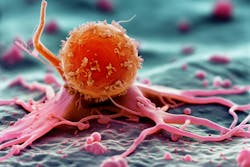Researchers at the Johns Hopkins Kimmel Cancer Center and Bloomberg~Kimmel Institute for Cancer Immunotherapy have developed a computer model to help scientists identify tumor-fighting immune cells in patients with lung cancer treated with immune checkpoint inhibitors.
In their study published February 3 in Nature Communications, the team, including first author Zhen Zeng, Ph.D., a bioinformatics research associate at the Kimmel Cancer Center, demonstrated that their three-gene “MANAscore” computer model can identify the immune-cells targeted by immune checkpoint inhibitor therapies. It also helped the team identify differences associated with patient response to immunotherapy.
The study’s senior author, Kellie Smith, Ph.D., helped develop the MANAFEST technology (Mutation-Associated NeoAntigen Functional Expansion of Specific T Cells), which she and colleagues first described in the journal Cancer Immunology Research in 2018. Their approach combined MANAFEST with single-cell sequencing to identify these rare immune cells in six patients with lung cancer, a laborious process that took several years and cost millions of dollars. The original study showed that the immunotherapy-activated immune cells share a common gene expression profile. In the new study, Zeng, Smith and their colleagues built on those discoveries to develop MANAscore.
The team also found key differences in the T cells activated in the tumors of patients who respond to immune checkpoint therapy compared with those who don’t.

